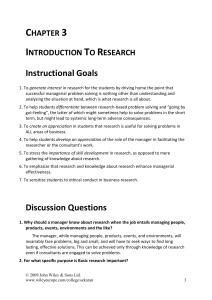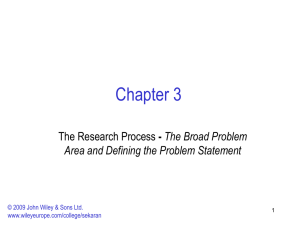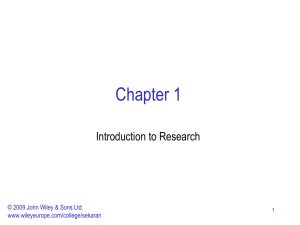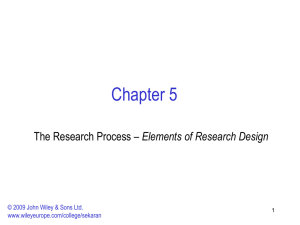Software Design - CSE,Dhaka City College
advertisement
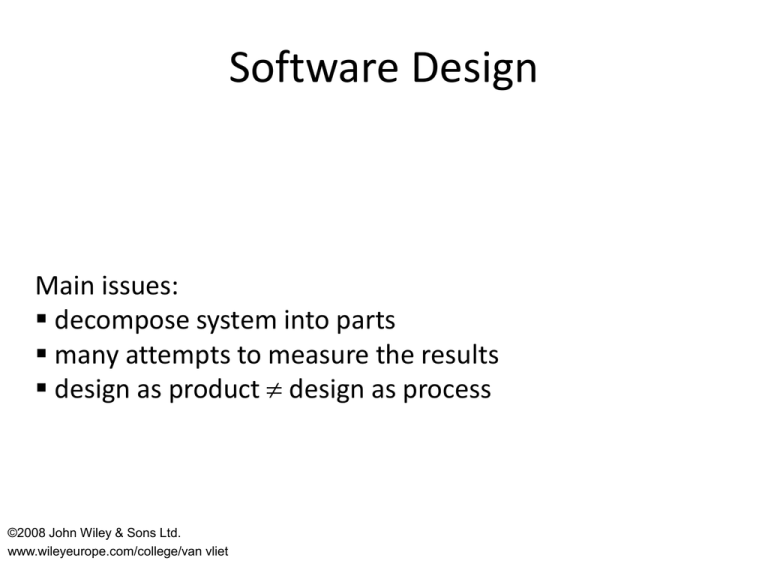
Software Design
Main issues:
decompose system into parts
many attempts to measure the results
design as product design as process
©2008 John Wiley & Sons Ltd.
www.wileyeurope.com/college/van vliet
Overview
• Introduction
• Design principles
• Design methods
• Conclusion
©2008 John Wiley & Sons Ltd.
www.wileyeurope.com/college/van vliet
2
Programmer’s Approach to
Software Engineering
Skip requirements engineering and design
phases;
start writing code
©2008 John Wiley & Sons Ltd.
www.wileyeurope.com/college/van vliet
3
Point to ponder
Is this the same as eXtreme Programming?
Or is there something additional in XP?
©2008 John Wiley & Sons Ltd.
www.wileyeurope.com/college/van vliet
4
Why this programmer’s approach?
• Design is a waste of time
• We need to show something to the customer real
quick
• We are judged by the amount of LOC/month
• We expect or know that the schedule is too tight
©2008 John Wiley & Sons Ltd.
www.wileyeurope.com/college/van vliet
5
However, ...
The longer you postpone coding, the sooner
you’ll be finished
©2008 John Wiley & Sons Ltd.
www.wileyeurope.com/college/van vliet
6
Up front remarks
• Design is a trial-and-error process
• The process is not the same as the outcome of
that process
• There is an interaction between requirements
engineering, architecting, and design
©2008 John Wiley & Sons Ltd.
www.wileyeurope.com/college/van vliet
7
Software design as a “wicked” problem
• There is no definite formulation
• There is no stopping rule
• Solutions are not simply true or false
• Every wicked problem is a symptom of
another problem
©2008 John Wiley & Sons Ltd.
www.wileyeurope.com/college/van vliet
8
Design Principles
• Abstraction
• Modularity, coupling and cohesion
• Information hiding
• Limit complexity
• Hierarchical structure
©2008 John Wiley & Sons Ltd.
www.wileyeurope.com/college/van vliet
9
Abstraction
• procedural abstraction: natural consequence
of stepwise refinement: name of procedure
denotes sequence of actions
abstraction
subproblems
time
©2008 John Wiley & Sons Ltd.
www.wileyeurope.com/college/van vliet
10
Abstraction
• data abstraction: aimed at finding a hierarchy
in the data
application-oriented
data structures
general
data structures
©2008 John Wiley & Sons Ltd.
www.wileyeurope.com/college/van vliet
simpler data
structure
11
Modularity
• structural criteria which tell us something about
individual modules and their interconnections
• cohesion and coupling
• cohesion: a measure of the mutual affinity of the
elements of a component; the degree of
relatedness among elements within the module
• coupling: the strength of the connection between
modules; the degree of interaction among
modules
©2008 John Wiley & Sons Ltd.
www.wileyeurope.com/college/van vliet
12
Types of Cohesion
• coincidental cohesion
• logical cohesion
• temporal cohesion
• procedural cohesion
• communicational cohesion
• sequential cohesion
• functional cohesion
• data cohesion (to cater for abstract data types)
©2008 John Wiley & Sons Ltd.
www.wileyeurope.com/college/van vliet
13
Cohesion Definitions
• Coincidental: no apparent connection
between elements
• Logical: elements perform tasks that can be
classified under a broad, general category
• Temporal: elements linked by the time at
which they are executed
• Procedural: elements are related by the order
of their occurrence
Cohesion Definitions (cont.)
• Communicational: elements all use the same
data set, but results of one stage of the
process are not passed on to other stages
• Sequential: elements take on a production line
interdependence
• Functional: every processing element is
essential to the performance of a single
function
How to determine the cohesion type?
• describe the purpose of the module in one sentence
• if the sentence is compound, contains a comma or more than one verb
it probably has more than one function: logical or communicational
cohesion
• if the sentence contains time-related words like “first”, “then”, “after”
temporal cohesion
• if the verb is not followed by a specific object probably logical cohesion
(example: edit all data)
• words like “startup”, “initialize” imply temporal cohesion
©2008 John Wiley & Sons Ltd.
www.wileyeurope.com/college/van vliet
16
Types of Coupling
• content coupling
• common coupling
• external coupling
• control coupling
• stamp coupling
• data coupling
©2008 John Wiley & Sons Ltd.
www.wileyeurope.com/college/van vliet
17
Coupling Definitions
• Content – when one module uses or modifies code in
another module
• Common – when modules reference a global data
area
• Control – when one module passes a flag to direct
the activity of another module
• Stamp – when information with some structural
characteristics is passed
• Data – when information passed is unstructured
Coupling levels are technology
dependent
• Data coupling assumes scalars or arrays, not
records
• control coupling assumes passing of scalar data
• nowadays:
– modules may pass complex data structures
– modules may allow some modules access to their
data, and deny it to others (so there are many levels
of visibility)
– coupling need not be commutative (A may be data
coupled to B, while B is control coupled to A)
©2008 John Wiley & Sons Ltd.
www.wileyeurope.com/college/van vliet
19
strong cohesion & weak coupling
simple interfaces
• simpler communication
• simpler correctness proofs
• changes influence other modules less often
• reusability increases
• comprehensibility improves
©2008 John Wiley & Sons Ltd.
www.wileyeurope.com/college/van vliet
20
Information Hiding
• each module has a secret
• design involves a series of decisions: for each such decision,
wonder who needs to know and who can be kept in the
dark
• information hiding is strongly related to
– abstraction: if you hide something, the user may abstract from
that fact
– coupling: the secret decreases coupling between a module and
its environment
– cohesion: the secret is what binds the parts of the module
together
©2008 John Wiley & Sons Ltd.
www.wileyeurope.com/college/van vliet
21
Point to ponder
• How many lines of code is this:
#include <stdio.h>
#define NULL 0
main ()
{
int i;
for (i=0;i<10;i++) printf(%d”,i);
}
©2008 John Wiley & Sons Ltd.
www.wileyeurope.com/college/van vliet
22
Complexity
• measure certain aspects of the software (lines of
code, # of if-statements, depth of nesting, …)
• use these numbers as a criterion to assess a
design, or to guide the design
• interpretation: higher value higher complexity
more effort required (= worse design)
• two kinds:
– intra-modular: inside one module
– inter-modular: between modules
©2008 John Wiley & Sons Ltd.
www.wileyeurope.com/college/van vliet
23
intra-modular
• attributes of a single module
• two classes:
– measures based on size
– measures based on structure
©2008 John Wiley & Sons Ltd.
www.wileyeurope.com/college/van vliet
24
Sized-based complexity measures
• counting lines of code
– differences in verbosity
– differences between programming languages
– a:= b versus
while p^ <> nil do p:= p^
• Halstead’s “software science”, essentially
counting operators and operands
©2008 John Wiley & Sons Ltd.
www.wileyeurope.com/college/van vliet
25
Software science basic entities
•
•
•
•
n1: number of unique operators
n2: number of unique operands
N1: total number of operators
N2: total number of operands
©2008 John Wiley & Sons Ltd.
www.wileyeurope.com/college/van vliet
26
Example program
public static void sort(int x []) {
for (int i=0; i < x.length-1; i++) {
for (int j=i+1; j < x.length; j++)
{
if (x[i] > x[j]) { operator, 1 occurrence
int save=x[i];
x[i]=x[j]; x[j]=save
}
}
}
operator, 2 occurrences
}
©2008 John Wiley & Sons Ltd.
www.wileyeurope.com/college/van vliet
27
operator
public
sort()
int
[]
{}
for {;;}
if ()
=
<
…
n1 = 17
©2008 John Wiley & Sons Ltd.
www.wileyeurope.com/college/van vliet
# of Occurrences
1
1
4
7
4
2
1
5
2
…
N1 = 39
28
Example program
public static void sort(int x []) {
for (int i=0; i < x.length-1; i++) {
for (int j=i+1; j < x.length; j++)
{
if (x[i] > x[j]) {
int save=x[i];
x[i]=x[j]; x[j]=save
}
operand, 2 occurrences
}
operand, 2 occurrences
}
}
©2008 John Wiley & Sons Ltd.
www.wileyeurope.com/college/van vliet
29
operand
x
length
i
j
save
0
1
n2 = 7
©2008 John Wiley & Sons Ltd.
www.wileyeurope.com/college/van vliet
# of occurrences
9
2
7
6
2
1
2
N2 = 29
30
Other software science formulas
•
•
•
•
•
•
•
•
size of vocabulary: n = n1 + n2
program length: N = N1 + N2
volume: V = N log2n
level of abstraction: L = V*/ V
approximation: L’ = (2/n1)(n2/N2)
programming effort: E = V/L
estimated programming time: T ’ = E/18
estimate of N: N ’ = n1log2n2 : n2log2n2
for this example: N = 68, N ’ = 89, L = .015, L’ = .028
©2008 John Wiley & Sons Ltd.
www.wileyeurope.com/college/van vliet
31
Software science
• empirical studies: reasonably good fit
• critique:
– explanations are not convincing
– results from cognitive psychology used wrongly
– is aimed at coding phase only; assumes this is an
uninterrupted concentrated activity
– different definitions of “operand” and “operator”
©2008 John Wiley & Sons Ltd.
www.wileyeurope.com/college/van vliet
32
Structure-based measures
• based on
– control structures
– data structures
– or both
• example complexity measure based on data
structures: average number of instructions
between successive references to a variable
• best known measure is based on the control
structure: McCabe’s Cyclomatic Complexity
©2008 John Wiley & Sons Ltd.
www.wileyeurope.com/college/van vliet
33
1
Example program
public static void sort(int x []) {
for (int i=0; i < x.length-1; i++) {
for (int j=i+1; j < x.length; j++) {
if (x[i] > x[j]) {
int save=x[i];
x[i]=x[j]; x[j]=save
}
}
}
}
2
3
4
5
11
6
7
8
9
©2008 John Wiley & Sons Ltd.
www.wileyeurope.com/college/van vliet
10
34
1
Cyclomatic complexity
2
e = number of edges (13)
n = number of nodes (11)
3
4
5
CV = e - n + 2 (4)
= number of predicates + 1
= number of regions
11
6
7
8
9
©2008 John Wiley & Sons Ltd.
www.wileyeurope.com/college/van vliet
10
35
Intra-modular complexity measures,
summary
• for small programs, the various measures correlate well
with programming time
• however, a simple length measure such as LOC does
equally well
• complexity measures are not very context sensitive
• complexity measures take into account few aspects
• it might help to look at the complexity density instead
(CV/LOC)
©2008 John Wiley & Sons Ltd.
www.wileyeurope.com/college/van vliet
36
System structure: inter-module
complexity
• looks at the complexity of the dependencies
between modules
• draw modules and their dependencies in a graph
• then the arrows connecting modules may denote
several relations, such as:
– A contains B
– A precedes B
– A uses B
• we are mostly interested in the latter type of
relation
©2008 John Wiley & Sons Ltd.
www.wileyeurope.com/college/van vliet
37
The uses relation
• In a well-structured piece of software, the
dependencies show up as procedure calls
• therefore, this graph is known as the callgraph
• possible shapes of this graph:
– chaos (directed graph)
– hierarchy (acyclic graph)
– strict hierarchy (layers)
– tree
©2008 John Wiley & Sons Ltd.
www.wileyeurope.com/college/van vliet
38
In a picture:
chaos
strict
hierarchy
©2008 John Wiley & Sons Ltd.
www.wileyeurope.com/college/van vliet
hierarchy
tree
39
Measurements
}
size
# nodes
# edges
height
width
©2008 John Wiley & Sons Ltd.
www.wileyeurope.com/college/van vliet
40
Deviation from a tree
hierarchy
strict
hierarchy
©2008 John Wiley & Sons Ltd.
www.wileyeurope.com/college/van vliet
tree
41
Tree impurity metric
• complete graph with n nodes has n(n-1)/2 edges
• a tree with n nodes has (n-1) edges
• tree impurity for a graph with n nodes and e
edges:
m(G) = 2(e-n+1)/(n-1)(n-2)
• this is a “good” measure, in the measurement
theory sense
©2008 John Wiley & Sons Ltd.
www.wileyeurope.com/college/van vliet
42
Desirable properties of any tree
impurity metric
• m(G) = 0 if and only if G is a tree
• m(G1) > m(G2) if G1 = G2 + an extra edge
• if G1 and G2 have the same # of “extra” edges wrt
their spanning tree, and G1 has more nodes than
G2, then m(G1) < m(G2)
• m(G) m(Kn) = 1, where G has n nodes, and Kn is
the (undirected) complete graph with n nodes
©2008 John Wiley & Sons Ltd.
www.wileyeurope.com/college/van vliet
43
Information flow metric
• tree impurity metrics only consider the number
of edges, not their “thickness”
• Henri & Kafura’s information flow metric takes
this “thickness” into account
• based on notions of local and global flow
• we consider a later variant, developed by
Shepperd
©2008 John Wiley & Sons Ltd.
www.wileyeurope.com/college/van vliet
44
Shepperd’s variant of
information flow metric
• there is a local flow from A to B if:
– A invokes B and passes it a parameter
– B invokes A and A returns a value
• there is a global flow from A to B if A updates some
global structure and B reads that structure
• fan-in(M) = # (local and global) flows whose sink is M
• fan-out(M) = # (local and global) flows whose source is
M
• complexity(M) = (fan-in(M) * fan-out(M))2
• Weakness: all flows count the same
©2008 John Wiley & Sons Ltd.
www.wileyeurope.com/college/van vliet
45
Object-oriented metrics
• WMC: Weighted Methods per Class
• DIT: Depth of Inheritance Tree
• NOC: Number Of Children
• CBO: Coupling Between Object Classes
• RFC: Response For a Class
• LCOM: Lack of COhesion of a Method
©2008 John Wiley & Sons Ltd.
www.wileyeurope.com/college/van vliet
46
Weighted Methods per Class
• measure for size of class
• WMC = c(i), i = 1, …, n (number of methods)
• c(i) = complexity of method i
• mostly, c(i) = 1
©2008 John Wiley & Sons Ltd.
www.wileyeurope.com/college/van vliet
47
Depth of Class in Inheritance Tree
• DIT = distance of class to root of its
inheritance tree
• DIT is somewhat language-dependent
• widely accepted heuristic: strive for a forest of
classes, a collection of inheritance trees of
medium height
©2008 John Wiley & Sons Ltd.
www.wileyeurope.com/college/van vliet
48
Number Of Children
• NOC: counts immediate descendants
• higher values NOC are considered bad:
– possibly improper abstraction of the parent class
– also suggests that class is to be used in a variety of
settings, which will make it more error prone.
©2008 John Wiley & Sons Ltd.
www.wileyeurope.com/college/van vliet
49
Coupling Between Object Classes
• two classes are coupled if a method of one class
uses a method or state variable of another class
• CBO = count of all classes a given class is coupled
with
• high values: something is wrong
• all couplings are counted alike; refinements are
possible
©2008 John Wiley & Sons Ltd.
www.wileyeurope.com/college/van vliet
50
More on CBO
• Although all couplings are considered equal, it
is reasonable to say:
– Access to state variables is worse than mere
parameter passing
– Access to elements of a foreign class is worse than
access to elements of a superclass
– Passing many complex parameters is worse than
passing a few simple parameters
– Messages that conform to Demeter’s Law are
better than those which do not
Demeter’s Law
• The Law of Demeter is a generally accepted design
heuristic for OO systems.
• It states that the methods of a class should depend only
on the top-level structure of their own class.
• More specifically, in the context of a class C with
method M, M should only send messages to
– The parameters of C
– The state variables of C
– C itself
Response For a Class
• RFC measures the “immediate surroundings” of a class
• RFC = size of the “response set”
• response set = {M} {Ri}, the set of messages that may
potentially be executed if a message is sent to an object of
class C.
• Messages are measured one level deep.
R1
M1
M2
M3
Larger values of RFC make comprehension of a class more difficult
and increase test time and complexity.
53
Lack of Cohesion of a Method
• cohesion = glue that keeps the module (class)
together
• if all methods use the same set of state variables:
OK, & that is the glue
• if some methods use a subset of the state variables,
and others use another subset, the class lacks
cohesion
• LCOM = number of disjoint sets of methods in a
class
• two methods in the same set share at least one
state variable
• The preferred value for LCOM is 0.
©2008 John Wiley & Sons Ltd.
www.wileyeurope.com/college/van vliet
54
OO metrics
• WMC, CBO, RFC, LCOM most useful
– Predict fault proneness during design
– Strong relationship to maintenance effort
• The merits of DIT and NCO remain somewhat
unclear
• Many OO metrics correlate strongly with size
• It remains questionable whether these
metrics tell more than a plain LOC code.
55
OOAD Methods
• three major steps:
1 identify the objects
2 determine their attributes and services
3 determine the relationships between objects
©2008 John Wiley & Sons Ltd.
www.wileyeurope.com/college/van vliet
56
(Part of) problem statement
Design the software to support the operation
of a public library. The system has a number of
stations for customer transactions. These
stations are operated by library employees.
When a book is borrowed, the identification
card of the client is read. Next, the station’s
bar code reader reads the book’s code. When
a book is returned, the identification card is
not needed and only the book’s code needs to
be read.
©2008 John Wiley & Sons Ltd.
www.wileyeurope.com/college/van vliet
57
Candidate objects
•
•
•
•
•
•
•
•
•
•
•
•
software
library
system
station
customer
transaction
book
library employee
identification card
client
bar code reader
book’s code
©2008 John Wiley & Sons Ltd.
www.wileyeurope.com/college/van vliet
58
Carefully consider candidate list
•
•
•
•
•
eliminate implementation constructs, such as “software”
replace or eliminate vague terms: “system” “computer”
equate synonymous terms: “customer” and “client” “client”
eliminate operation names, if possible (such as “transaction”)
be careful in what you really mean: can a client be a library employee? Is it
“book copy” rather than “book”?
• eliminate individual objects (as opposed to classes). “book’s code”
attribute of “book copy”
©2008 John Wiley & Sons Ltd.
www.wileyeurope.com/college/van vliet
59
Relationships
•
From the problem statement:
–
–
–
–
•
employee operates station
station has bar code reader
bar code reader reads book copy
bar code reader reads identification card
Tacit knowledge:
–
–
–
–
–
–
library owns computer
library owns stations
computer communicates with station
library employs employee
client is member of library
client has identification card
©2008 John Wiley & Sons Ltd.
www.wileyeurope.com/college/van vliet
60
Result: initial class diagram
©2008 John Wiley & Sons Ltd.
www.wileyeurope.com/college/van vliet
61
Usage scenario sequence diagram
©2008 John Wiley & Sons Ltd.
www.wileyeurope.com/college/van vliet
62
Antipatterns
• Patterns describe desirable behavior
• Antipatterns describe situations one had better
avoid
• In agile approaches (XP), refactoring is applied
whenever an antipattern has been introduced
©2008 John Wiley & Sons Ltd.
www.wileyeurope.com/college/van vliet
63
Example antipatterns
• God class: class that holds most responsibilities
• Lava flow: dead code
• Poltergeist: class with few responsibilities and a
short life
• Golden Hammer: solution that does not fit the
problem
• Stovepipe: (almost) identical solutions at different
places
• Swiss Army Knife: excessively complex class
interface
©2008 John Wiley & Sons Ltd.
www.wileyeurope.com/college/van vliet
64
Conclusion
• Essence of the design process: decompose
system into parts
• Desirable properties of a decomposition:
coupling/cohesion, information hiding, (layers of)
abstraction
• There have been many attempts to express these
properties in numbers
©2008 John Wiley & Sons Ltd.
www.wileyeurope.com/college/van vliet
65

